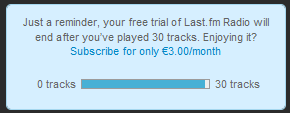When Last.fm announced they would start charging for their streaming music service in March, I decided to uninstall their scrobbler client from my PC (you know, that little app that listens to what you are listening to and posts it on your Last.fm profile). I had been using the service for two years, but felt that it didn’t quite deliver on its promise, at least for me. Sure, it was fun to publish your playlist through the service, and occasionally also to listen to the “radio channels” that Last.fm generates based on the listening habbits of similar users. Still, it was nothing that I was willing to start subscribing to. A paid service would mean that you should also mentally commit to be an active user, which it turned out, I wasn’t. €3 is a small amount, until you ask me to perform the actual payment.
Months went by and along came Spotify. Instead of being free first, then going paid, there was always a solid freemium pricing model set up for the service. After listening to the ads on Spotify for a couple of weeks, I was more than happy to pay €10 per month for the no-ads, higher quality service. Lesson number 1: never ask the users to start paying for something that used to be free for them. Paying must give you more, not just more of the same.
Spotify does a fairly good job in the basic music player functionality, but otherwise the service is shallow. The recommendations and new additions provide a very rudimentary interface to explore the content of the Spotify database. This means that most of the time you will need to come up with the artist or track name you want to search for in some other context, then try your luck on possibly finding the right music on Spotify. You can’t collect a usable library of the albums you have listened to or want to in the future (which is what I use Tumblr for as a temporary solution). Furthermore, there’s no community aspect to the service whatsoever, which in the year 2009 cannot be considered just a nice-to-have feature anymore.
Re-enter Last.fm. I didn’t initially pay any attention to the Spotify settings menu, since there are not too many things to configure in the player anyway. Nevertheless, it turns out there’s been a native Last.fm scrobbling feature built into the Spotify client for almost a year already. So, just by entering the account information, my up-to-date playlists were back in Last.fm. With the addition of this nice little Greasemonkey script, launching the Last.fm tracks right from Firefox is also a breeze. Even more apps/mashups can be found from here.
Last.fm’s CFO has stated that they don’t view Spotify as a rival but rather a collaborator. While that might sound like the typical corporate talk where everyone’s always a leading provider in their own little niche market as defined by themselves, there’s a lot more wisdom behind this particular statement. Lesson 2: Don’t reinvent the wheel, unless you plan on learning more about wheels. (Ok, I ripped that from Jeff Atwood, but I’m just practicing what he’s preaching.) Sure it would be perfectly possible for Spotify to build their own community features into their client, but why would they bother? It’s all there already, just integrate the two services and let them both focus on their strengths (and come up with a fair revenue sharing model, which is easier said than done). I’ll be a happy user of them both.




One Response
Stay in touch with the conversation, subscribe to the RSS feed for comments on this post.
Continuing the Discussion